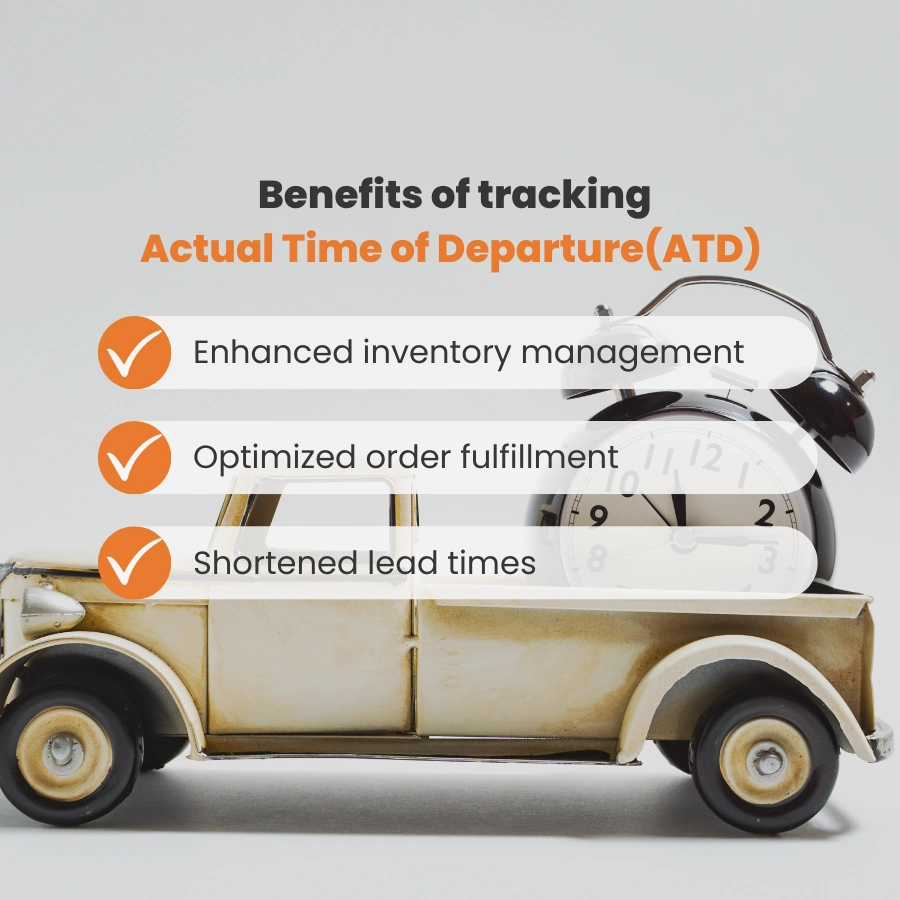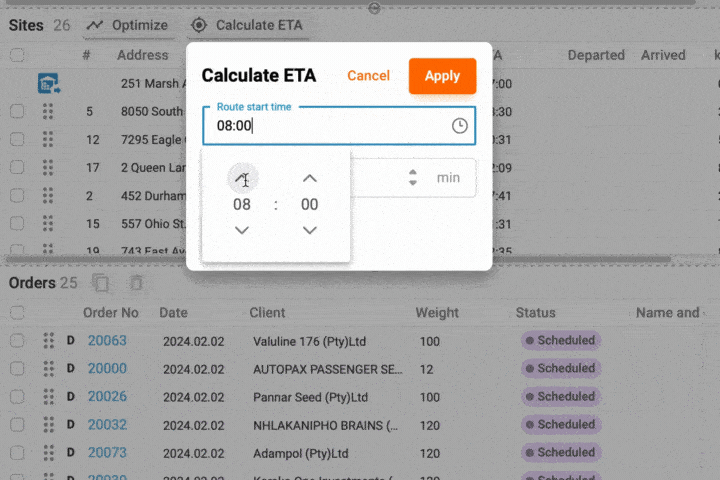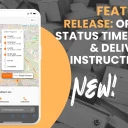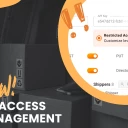What Is ATD and Why Does It Matter?
Updated on
March 08, 2024
by
Jennifer Collins

In the logistics and transportation industry, Actual Time of Departure (ATD) plays a crucial role in ensuring operational efficiency and customer satisfaction. ATD refers to when a vehicle or shipment leaves its origin point. It's a critical component in the supply chain, influencing delivery timelines, inventory management, and overall customer experience.
Timely departures minimize delays, optimize routes, and facilitate smooth transitions between different stages of transportation. For businesses, meeting ATDs is not just about adhering to schedules; it's about building trust and reliability with customers.
When ATD differs from ETD, it creates several problems. For example, if shipments leave later than expected, customers won't know precisely when their packages will arrive, making them unhappy.
For example, if packages are late, customers won't know exactly when they will get their orders. This can make them upset. Also, being late can cause more problems with delivering the packages, such as not having trucks or drivers available when needed, leading to further delays.
By using tools like GPS tracking and watching everything in real-time, companies can plan better, avoid delays as much as possible, and improve their operations overall in the shipping world.
Let's explore ATD's meaning and why it's essential in logistics!
Understanding ATD meaning
ATD, or Actual Time of Departure, is important for companies that move goods around. It tells them exactly when something has been sent off. Knowing the ATD helps these companies work better and make their customers happier.

By understanding when a truck leaves with goods, businesses can monitor what's happening in real time. This lets them organize their transport better and quickly fix any schedule changes.
Accurate ATD information helps with planning routes, managing trucks, scheduling deliveries, and keeping stock up to date. It's crucial for making smart decisions when moving goods from one place to another.
Without tracking ATD, companies have to guess when things will happen, often leading to mistakes and delays. This makes it hard to plan properly and work smoothly together.
Understanding the differences: ATD vs. ETD
Let's clear up the confusion between Actual Time of Departure (ATD) and Estimated Time of Departure (ETD) with a simple tale:
|
Aspect |
ATD (Actual Time of Departure) |
ETD (Estimated Time of Departure) |
|
Definition |
The precise moment when a vehicle or shipment leaves its origin point. |
An anticipated time frame for departure based on forecasts or scheduling. |
|
Accuracy |
Provides real-time data on actual departure times. |
Offers a projected departure time, subject to change. |
|
Reliability |
Offers accurate insights into departure performance. |
It may not always align with actual departure times. |
|
Impact |
Facilitates efficient scheduling and optimization of logistics operations. |
Serves as a planning reference but may require adjustments in response to deviations. |
|
Importance in logistics operations |
Crucial for monitoring supply chain efficiency and responsiveness. |
Provides a baseline for planning and coordination but lacks real-time accuracy. |
|
Example scenario |
A logistics company tracks the ATD of its trucks in real time, allowing for proactive adjustments to optimize routes and delivery times. |
A shipping company informs customers that their package will depart at 9:00 AM based on their scheduling system. However, the actual departure occurs at 10:30 AM due to unforeseen delays. |
Importance of ATD in logistics operations
ATD is of immense importance to logistics and transportation companies. ATD impacts operations, such as route planning, fleet management, and delivery schedules. This knowledge helps them plan better routes, manage their vehicles wisely, and deliver things on time.
Additionally, ATD enables effective fleet management by ensuring vehicles depart on schedule, allowing for timely adjustments and improved operational efficiency.
With up-to-date information on departures, companies can use their resources without wasting time or space. This careful planning saves money by cutting down costs related to fuel, staff hours, and taking care of vehicles. Plus, sticking to a schedule means customers get what they need precisely when expected - this makes customers happy and builds a strong reputation for the company.
Compared to the ETD, continuous delays in the ATD signify underlying issues within logistics and transportation operations.
If these delays keep happening, planning routes, managing vehicles or ships, or distributing resources isn't being done well. These issues can lead to higher costs for the company, unhappy customers, and a bad reputation.
Not dealing with these delays can result in losing business opportunities and falling behind competitors. So, taking action early to determine why these delays are happening and fixing them is key to keeping everything running smoothly.
Improving supply chain visibility with ATD data
Knowing exactly when shipments leave helps people who manage supply chains to see and track their goods more clearly, handle stock levels better, speed up getting orders out, and cut down on waiting times.

Let's see how:
Enhancing inventory management
When companies watch their goods leave storage, they get a clearer picture of what's happening in their business. This correct information helps them spot problems, irregularities, and changes that affect how smoothly their supply chain works.
Optimizing order fulfillment
With trustworthy information via ATD on when things are shipped, those in charge of inventory can better prepare and manage their stock before new items arrive.
If a shipment is late, they can change their plans to ensure they don't run out of items or have too many left over. Also, knowing exactly when something will ship helps businesses promise more accurate delivery times.
Shortening lead times
By monitoring the time that products leave, companies can take early action to shorten delivery times. This means they can figure out and fix the main reasons for delays in shipping, make loading processes smoother, and choose better paths for transportation.
In short, knowing exactly when goods are dispatched is essential for improving how a supply chain works.
Challenges and solutions in capturing and using ATD data
Accurate information is essential for logistics workers to ensure everything runs smoothly and customers are happy.
But, getting and using this information can be difficult, slowing down work and reducing profits. It's essential for businesses to get better at handling this information so they can stay ahead of competitors, keep costs down, make customers happier, and grow their business.
Now, let's discuss some of the main problems with managing this information and share some good ways to collect it properly. We'll also look at how we analyze the data effectively and use it fully.
Data inaccuracies
One big problem with handling ATD data is that mistakes can easily happen. People who enter data by hand might make typos or other errors. If the address information isn't entirely correct, it's another issue because you need complete and accurate details for customers and deliveries.
Also, if shipments are labeled wrong - meaning they have incorrect tracking numbers or labels - it makes it hard for companies to track where packages go.
These mistakes can lead to lost packages, deliveries not being made, and messed-up information about shipping paths, which company carries the items, the costs involved, and how long shipments take. Without clear and correct primary data from the start, everything that comes after gets poorly affected.
To avoid these problems becoming more significant later on, companies must check addresses carefully, re-check any data entered by hand very closely, and ensure every shipment has the correct label before sending it off. This way, minor errors don't turn into significant roadblocks.
Technological limitations
Many shipping companies use old systems and technology that can't gather all the information needed for complete shipment tracking. These older systems have several problems:
- They can't read new types of barcodes or follow newer tracking methods because their scanners are outdated.
- Different software, like those used in warehouses or for transport management, don't work well together, creating data blocks.
- They cannot track shipments as they happen in real-time.
- These platforms often can't capture pictures, videos, or other data showing proof of delivery.
- Connecting with new gadgets like Internet-of-Things sensors, smartphones, and RFID readers is challenging due to compatibility issues with old software.
- These systems' tools aren't good at analyzing data and making valuable reports.
Without updated systems designed to collect and analyze data correctly, shipping companies have difficulty keeping up with current needs for tracking shipments and understanding supply chains. Modern solutions built specifically for handling detailed shipment tracking could solve these tech challenges.
One such tool is Track-POD, a software solution designed to help solve everyday problems in the logistics industry. It offers advanced features that make managing deliveries more accessible and more accurate.
With Track-POD’s logistic management software, workers can track shipments as they happen, ensuring all delivery times are recorded correctly. The software is easy to use, reducing mistakes and making it more straightforward for staff to enter and find information.
Moreover, for dispatchers seeking to adjust route plans and reoptimize estimated time of arrival (ETA), Track-POD provides a straightforward process:
- Step 1: In route settings within Track-POD's logistic management software, locate and click the "Calculate ETA" button.
- Step 2: Once clicked, a prompt will appear where you can enter the new Route Start Time. Input the desired time and click "Apply" to confirm the changes.
- Step 3: After applying the new Route Start Time, observe how the system automatically reoptimizes the delivery route based on the updated arrival time.

Also, Track-POD works well with other systems companies might already be using, helping everything run smoothly together. Using Track-POD, logistics professionals can get past tech challenges, improve how they record and use delivery data, and make their operations more efficient.
Compliance issues
People who work in shipping and delivery have to follow many strict rules, especially when sending things to other countries.
They need to ensure all their information about deliveries (ATD data) follows these rules, covering everything from safety and taxes to privacy. Here are some common problems they face:
- There are limits on how long drivers can be on the road. ATD data must show these rules are being followed.
- When something gets delivered from one person or company to another, there needs to be clear records of who had it and when; missing information could cause issues.
- Privacy laws like GDPR demand that people agree before their info is used, so mishandling ATD data could get companies in trouble for breaking those laws.
- Tax and money-related rules mean that all financial records from ATD must be accurate; mistakes here can lead to big headaches.
- Safety checks—like ensuring vehicles are okayed by maintenance, loaded correctly, etc.—rely on good ATD documentation, too; ignoring these can result in fines or even shutting operations down.
- Security steps for checking cargo also depend on this kind of data; there might be penalties without proof that procedures were followed.
- Environmental standards regarding fuel use and dealing with waste materials also require complete and accurate ADT tracking.
Keeping up with all these different regulations keeps changing. It is challenging since each place has its rules, but managing the information well through better systems integration training audits helps avoid breaking them while getting the most out of using ADT data effectively.
Integration challenges
Merging data from different places can be challenging for companies that manage deliveries. The main problem is dealing with information from various forms and other systems.
For instance, details about a delivery's arrival might be kept in one system, where the truck is tracked through GPS tracking in another, and updates from the shipping company in a third. Putting all this information together into one clear picture usually requires extra work by hand.
Another significant issue is adding information from outside partners, such as shipping updates. These partners often have their own way of formatting their data, which might not easily connect with other systems.
Doing all this manually, such as filling out spreadsheets with status reports and then uploading them, takes a lot of effort and can lead to mistakes. Having to make different types of data match up adds complexity.
Without an automatic process, it's hard to get an up-to-date view that combines all the sources of information both inside and outside the company.
Lack of standardized processes
Challenges in ATD data often happen because there's no standard way to collect, handle, and use the data throughout the supply chain. When everyone does things differently, it leads to problems.
For instance, some might write down information by hand while others use barcode scanners. The information recorded at the start of a shipment might not match what's recorded at the end if it was written on paper first.
There are also issues with how data is named, stored, and shared. These differences can cause errors and mix-ups that make the data less trustworthy. Important details can be lost or messed up as they move through different systems without talking to each other well.
Sometimes, essential pieces of information are missing or filled out wrong. Things would be much better if everyone in the supply chain followed the same steps for dealing with data. Having agreed on ways to collect, keep track of formats, and share data would make it more reliable.
Getting this right is key to using ATD to move goods around efficiently.
Conclusion: driving operational excellence with ATD
ATD is very important in today's shipping and transportation world. Recording and using the time when something leaves correctly helps make planning routes better, manage vehicles more effectively, and boost how well the whole supply chain works.
By solving usual problems and putting in place fixes, companies can take advantage of ATD to make their operations smoother and offer better customer service. It's crucial for those working in logistics to understand how vital ATD is and focus on keeping track of it accurately.
Ultimately, putting money into ATD technology and methods is essential for staying ahead in the fast-changing world of logistics and meeting current market needs.




